Gameplay Performance – Ray Tracing
In the gaming performance below, we are comparing performance at 1440p with Ray Tracing enabled, as this is the prime target resolution for these graphics cards. We are using an AMD Radeon RX 7900 XT reference AMD card and a factory overclocked PowerColor Hellhound Radeon RX 7900 GRE video card (7900 GREs are factory overclocked, there is no reference card), as well as the ASUS PRIME GeForce RTX 5070 Ti (which runs at NVIDIA reference clock speeds for the RTX 5070 Ti).
Alan Wake 2
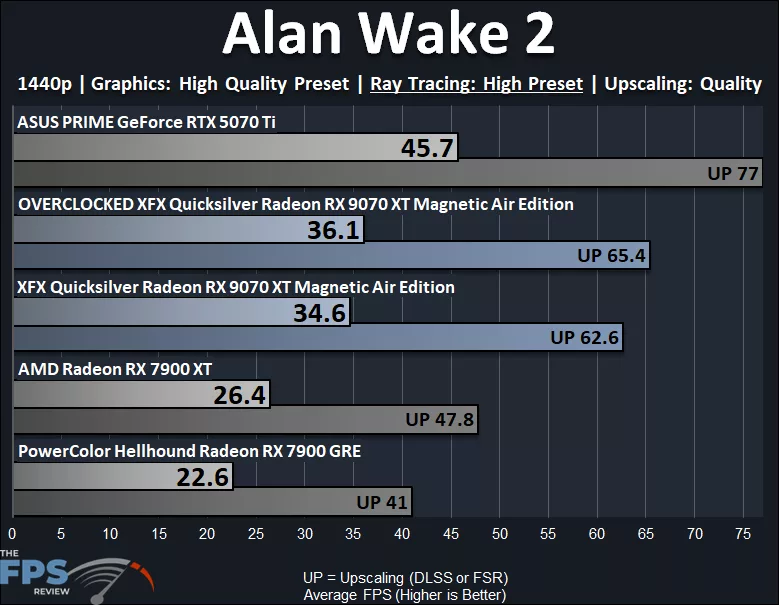
In Alan Wake 2, we are running at 1440p with the “High” quality Ray Tracing preset enabled, not the new Ultra quality; this is one setting down from Ultra. This was required because the new Ultra RT mode is not available on AMD Radeon GPUs; to make a comparison, we must use the High RT preset.
The first thing to note is that there has been a marked improvement in Ray Tracing performance with RDNA 4, this graph clearly shows that, however, it still cannot compete with the competition on that level. At 1440p with RT, the XFX Quicksilver AMD Radeon RX 9070 XT Magnetic Air Edition does not provide a playable gameplay experience at native resolution, we do need to enable FSR Upscaling Quality mode, and with that, performance is now at 60 FPS, and the game is very playable. Therefore, Alan Wake 2 IS playable at 1440p and High RT on the Radeon RX 9070 XT as long as we use Quality FSR Upscaling. This is something the previous generation AMD Radeon GPUs could not provide at all.
The XFX Quicksilver AMD Radeon RX 9070 XT Magnetic Air Edition is 24% slower than the GeForce RTX 5070 Ti, but is 31% faster than the Radeon RX 7900 XT, showing a marked generational RT improvement. Overclocking buys us 4% more performance.
Black Myth: Wukong
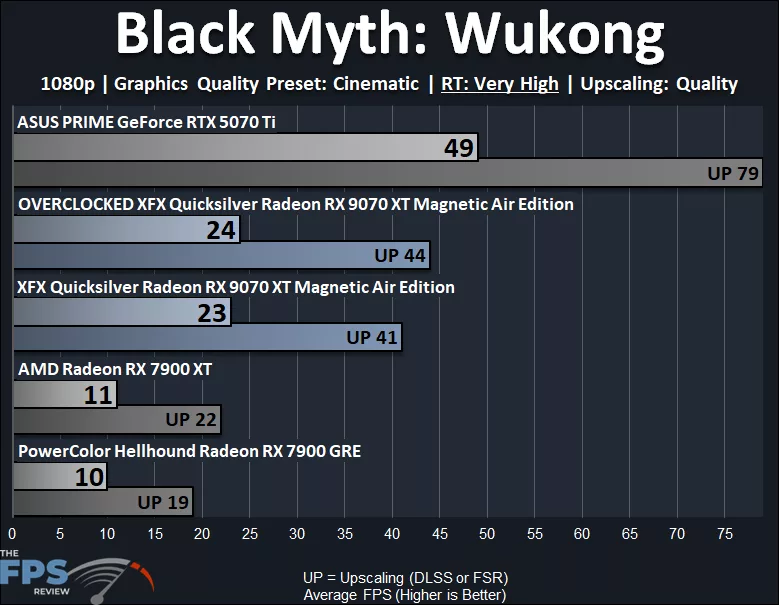
In Black Myth: Wukong we did have to drop this game to 1080p just to get a benchmark run done due to the tremendous burden on performance when the “Very High” RT option is enabled in this game. At 1080p and Very High RT the XFX Quicksilver AMD Radeon RX 9070 XT Magnetic Air Edition does not provide a playable experience, even with Quality FSR Upscaling enabled, it’s still not enough. In this game, RT will only be usable at the lower quality levels, or aggressive FSR on the Radeon RX 9070 XT.
The XFX Quicksilver AMD Radeon RX 9070 XT Magnetic Air Edition ends up being 53% slower than the GeForce RTX 5070 Ti with RT enabled. The XFX Quicksilver AMD Radeon RX 9070 XT Magnetic Air Edition is, though, 109% faster than the Radeon RX 7900 XT, so that’s huge.
Cyberpunk 2077
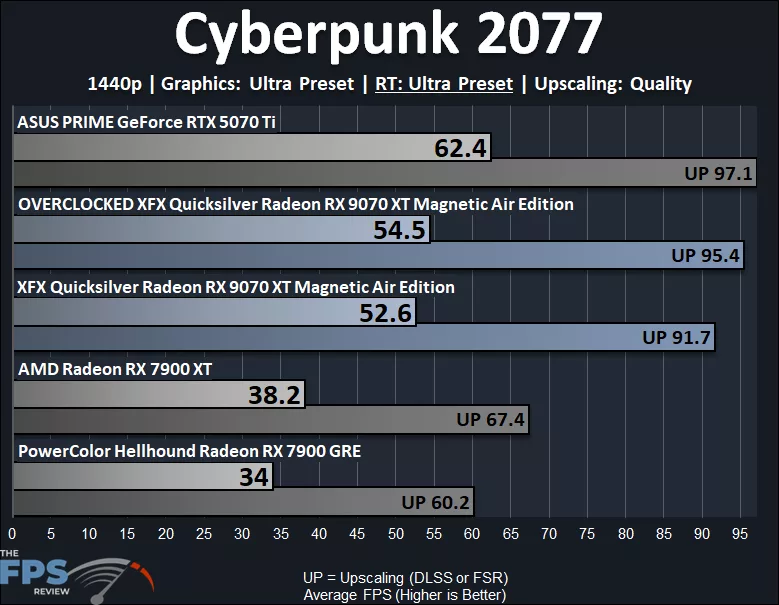
In Cyberpunk 2077, we are running at 1440p with the “Ultra” Ray Tracing feature enabled; this is not Path Tracing. The XFX Quicksilver AMD Radeon RX 9070 XT Magnetic Air Edition does not really provide a playable experience at 1440p with RT enabled here at native resolution. We do need to enable FSR Quality Upscaling to make the Radeon RX 9070 XT playable with RT, and then performance is at 90 FPS average which is great. This is much better than the Radeon RX 7900 XT, a very big improvement.
The XFX Quicksilver AMD Radeon RX 9070 XT Magnetic Air Edition is 16% slower than the GeForce RTX 5070 Ti with Ultra RT in this game. The XFX Quicksilver AMD Radeon RX 9070 XT Magnetic Air Edition is 38% faster than the Radeon RX 7900 XT, however, which is a big improvement from the previous generation. Overclocking provides a 4% performance uplift.
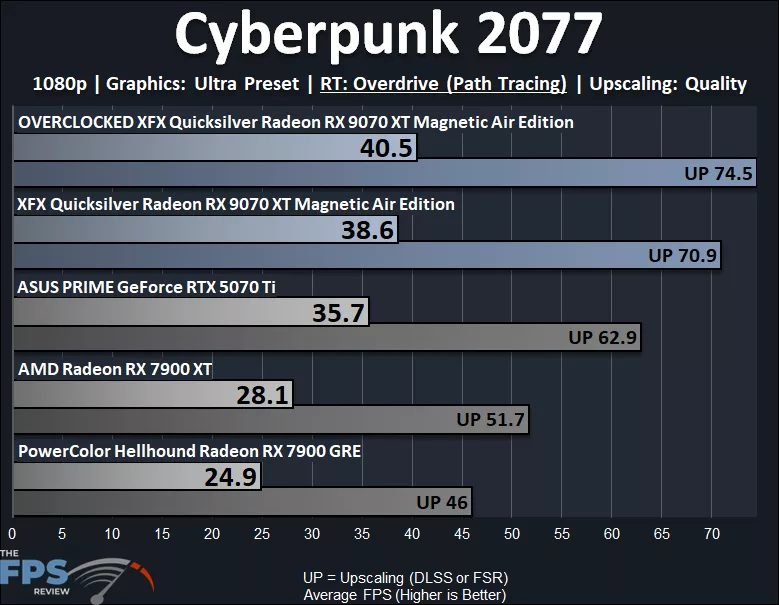
We wanted to test Cyberpunk 2077’s Ray Tracing Overdrive (Path Tracing) mode on the new Radeon RX 9070 XT. Above, we are running at 1080p with RT Overdrive Path Tracing enabled. This is a shocker, for the first time, the AMD Radeon card is faster at an RT mode compared to the competition. The XFX Quicksilver AMD Radeon RX 9070 XT Magnetic Air Edition is actually playable at 1080p with RT Overdrive Path Tracing with FSR Upscaling enabled!
The XFX Quicksilver AMD Radeon RX 9070 XT Magnetic Air Edition is 8% faster than the GeForce RTX 5070 Ti, and 37% faster than the Radeon RX 7900 XT. Overclocking provides a 5% performance uplift.
Dying Light 2
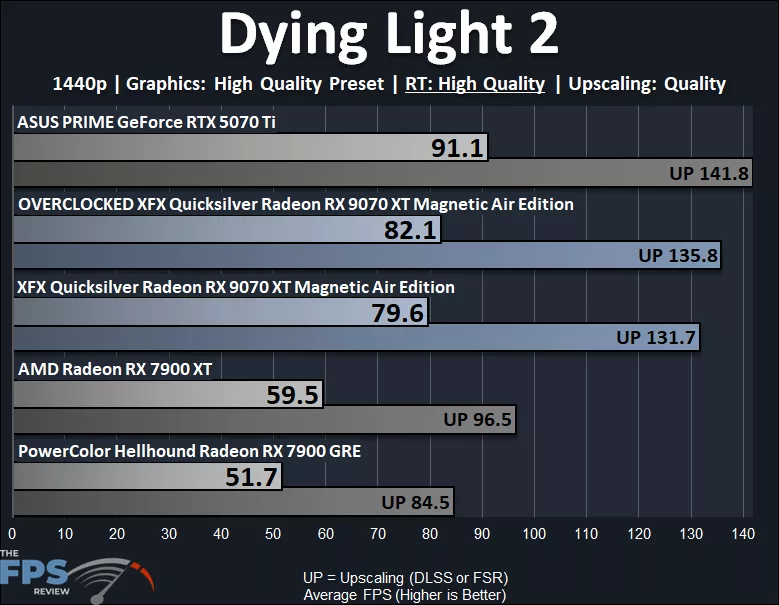
In Dying Light 2, the XFX Quicksilver AMD Radeon RX 9070 XT Magnetic Air Edition provides a playable gameplay experience with Ray Tracing at 1440p and native resolution near 80 FPS average. With FSR Upscaling that is up to 130 FPS average. The XFX Quicksilver AMD Radeon RX 9070 XT Magnetic Air Edition is 13% slower than the GeForce RTX 5070 Ti, and 34% faster than the Radeon RX 7900 XT.
F1 24
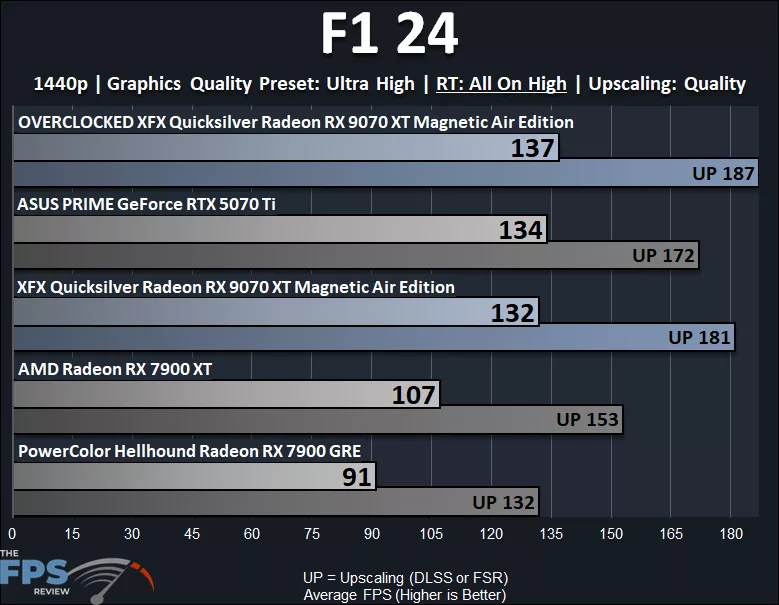
In F1 24 the XFX Quicksilver AMD Radeon RX 9070 XT Magnetic Air Edition provides a playable experience at 132 FPS and actually matches the GeForce RTX 5070 Ti in performance and experience with Ray Tracing. The XFX Quicksilver AMD Radeon RX 9070 XT Magnetic Air Edition is only 1.4% behind the GeForce RTX 5070 Ti, and it is 23% faster than the Radeon RX 7900 XT. Overclocking provides a 4% performance uplift.
Star Wars Outlaws
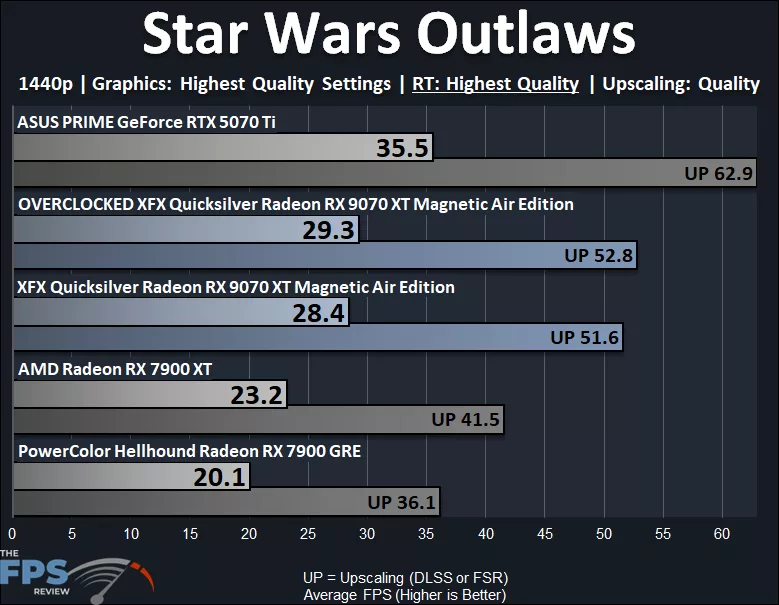
Star Wars Outlaws is very demanding at 1440p with Ultra Ray Tracing. The XFX Quicksilver AMD Radeon RX 9070 XT Magnetic Air Edition can’t quite provide a playable experience, even with FSR Quality Upscaling enabled. For this game, you will have to use a more aggressive FSR setting like Balanced FSR at 1440p to achieve a playable experience on the Radeon RX 9070 XT with Ultra RT enabled.
The XFX Quicksilver AMD Radeon RX 9070 XT Magnetic Air Edition is 20% slower than the GeForce RTX 5070 Ti, and 22% faster than the Radeon RX 7900 XT. Overclocking doesn’t provide much benefit, the game is very bottlenecked with RT enabled here.
